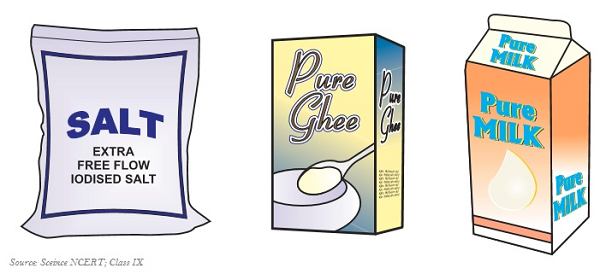
- Chemistry - Home
- Matter In Our Surroundings
- Is Matter Around Us Pure
- Chemistry - Atoms & Molecules
- Chemistry - Structure Of The Atom
- Chemical Reactions and Equations
- Chemistry - Acids, Bases, and Salts
- Materials: Metals and Non-Metals I
- Chemistry - Metals & Non-Metals II
- Carbon & its Compounds
- Periodic Classification Of Elements
- Synthetic Fibres and Plastics
- Chemistry - Coal And Petroleum
- Chemistry - Combustion And Flame
Chemistry - Is Matter Around Us Pure
Introduction
A pure substance is that that consists of single type of particle or particles.

Mixtures of two or more pure components without any undesirable substance are known as Mixtures, for example, water, minerals, soil etc.
A homogeneous mixture of two or more substances is known as solution. For example, lemonade, soda water etc.
Solution could be in any form such as it could be in liquid, solid, or gaseous.
Alloys are another example of mixture that contain homogeneous mixtures of metals; they cannot be separated into their components by physical methods. E.g. For example, brass is a mixture of zinc (approximately 30%) and copper (about 70%).
Significant Features of Solution
Solution is normally a homogeneous mixture.
The particles of a solution are even smaller than 1 nm (10-9 meter) in diameter and hence, these are not visible from the naked eyes.
The path of light is not visible in a solution.
The dissolved particles cannot be separated from the mixture by the simple process of filtration.
The dissolved particles do not settle down when it left undisturbed.
At a given temperature, when no more solute can be dissolved in a solution, it is known as saturated solution.
At a given temperature, the amount of the dissolved particles present in the saturated solution, is known as solubility.
Suspension
A suspension is a heterogeneous mixture in which the solute particles do not dissolve, but rather remain suspended throughout the bulk of the medium, is known as suspension.
Significant features of Suspension
Particles of a suspension are clearly visible from the naked eye.

The particles of a suspension scatter a beam of light that passes through it and likewise, its path is visible.
The salute particles can be separated from the mixture by the simple process of filtration.
Colloid
A heterogeneous mixture is known as colloid. E.g. mist, fog, smoke, face cream, etc.

The size of colloid particles is too small to see from the naked eye.
Colloid particles are big enough to scatter a beam of light passing through it and make the path visible.
Colloid particles cannot be separated from the mixture by the simple process of filtration.
The special filtration technique i.e. centrifugation, can be used to separate the colloidal particles.
Chromatography
The process of separation of components of a mixture is called as chromatography; normally it is used for the color separation.
Chromatography technique is used for separation of those solutes that dissolve in the same solvent.
Distillation
The process of purifying a liquid by heating and cooling means is known as distillation.
Crystallization
The process that separates a pure solid in the form of its crystals from a solution is known as crystallization.
Elements
In 1661, Robert Boyle was the first scientist who used the term element; Antoine Laurent Lavoisier, a French chemist, was the first who experimentally define the term element.
Element is as a basic form of matter that cannot be broken down into simpler substances by a chemical reaction.
Elements normally can be categorized as metals, non-metals, and metalloids.
Metal
A solid material, which typically is hard, ductile, malleable, shiny, and fusible with good electrical and thermal conductivity, is known as metal. E.g. gold, silver, copper, aluminum, etc.

Mercury is the only metal that remains liquid at room temperature.
Non-metal
All elements or substances, which are not metals, are known as non-metals. E.g. hydrogen, oxygen, iodine, carbon, etc.
Non-metals have variety of colors and they are poor conductors of heat and electricity.
Non-metals are not lustrous, sonorous, or malleable.
Compound
A substance, composed of two or more elements, is known as compound.
Compound is the result of the chemically combination of two or more elements in a fixed proportion.

Properties of a compound are somehow different from its constituent elements, whereas, the properties of a mixture are the same as of its constituting elements or compounds.